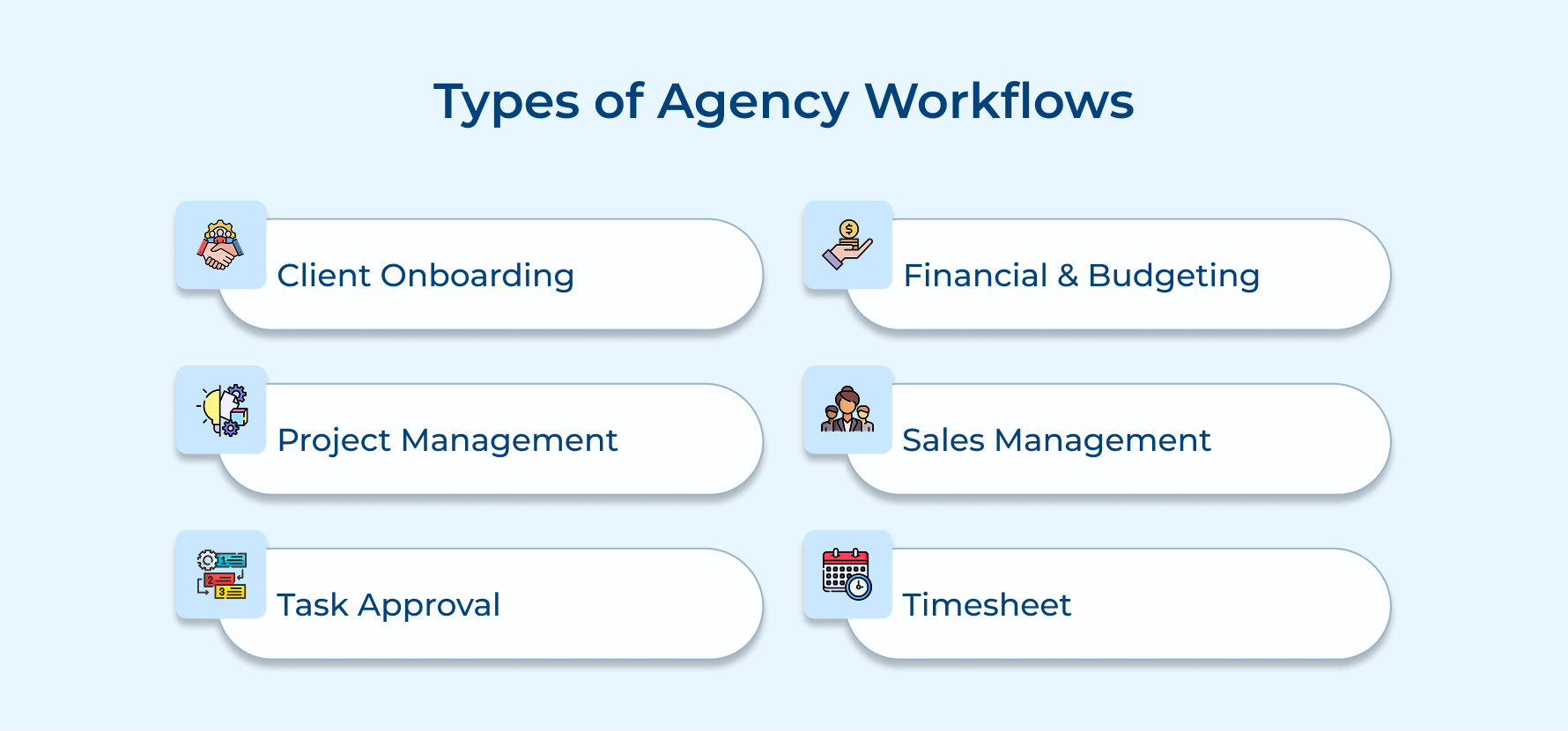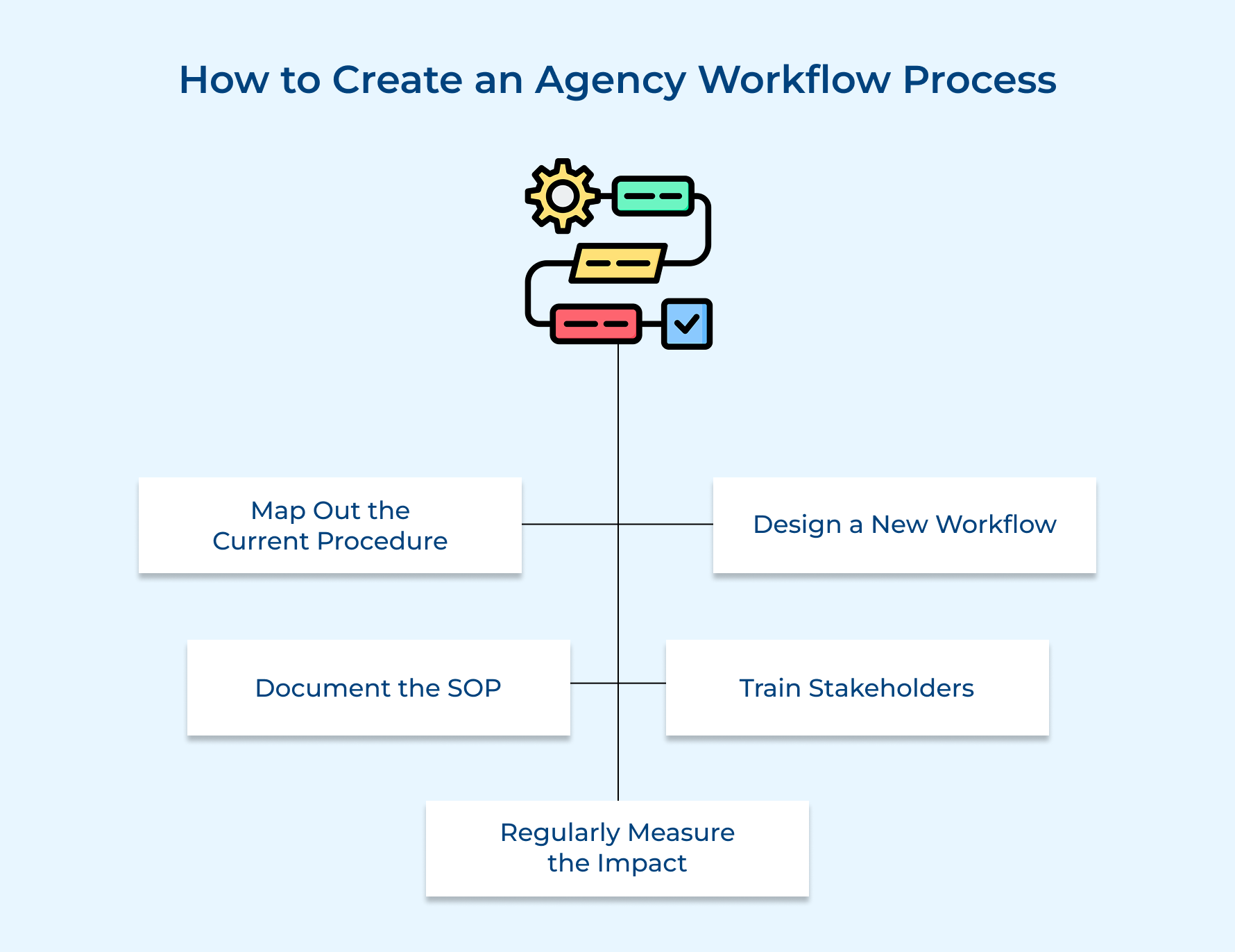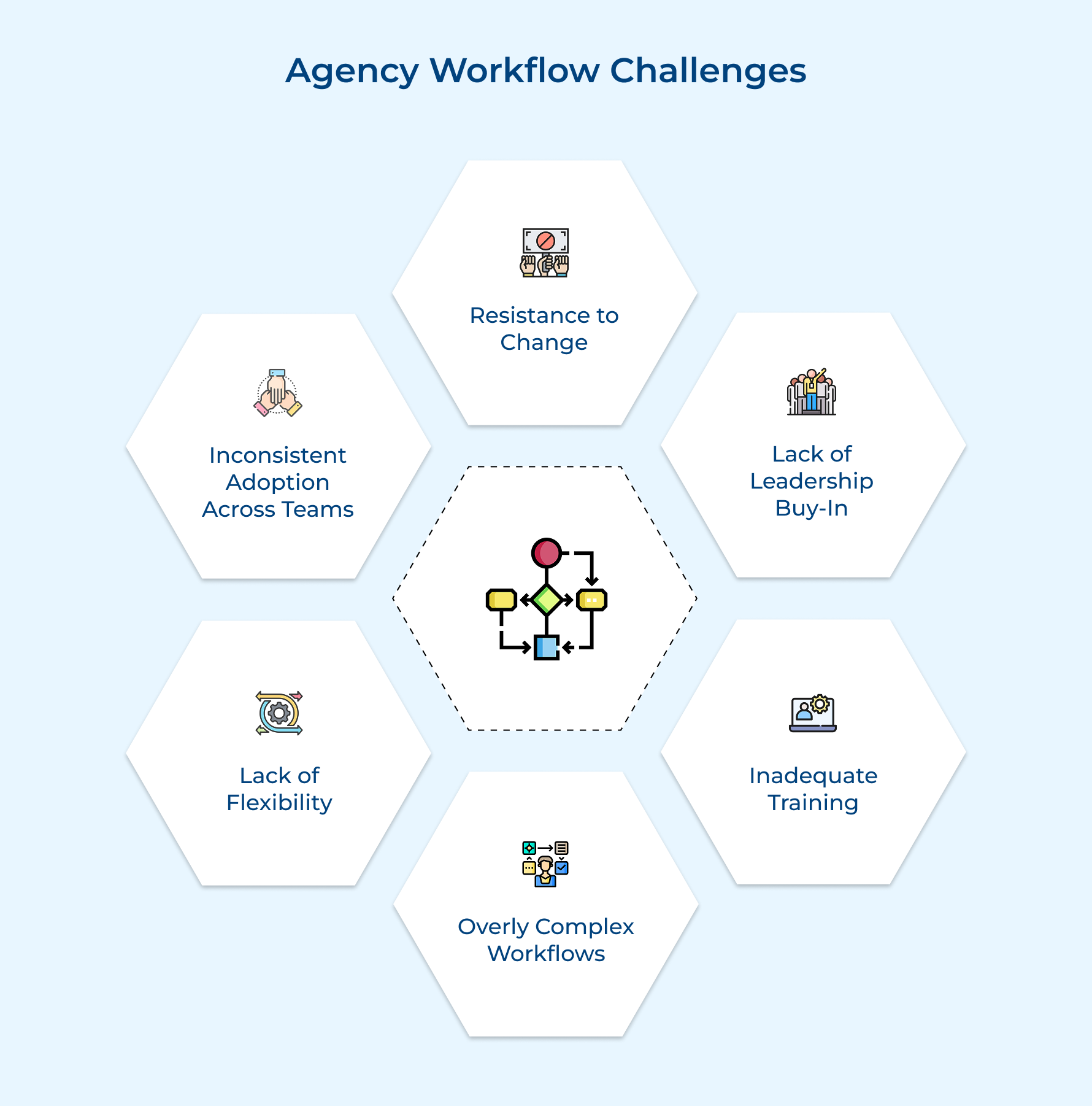What is an Agency Workflow: A Complete Guide
- What are Agency Workflows?
- Types of Agency Workflows
- How to Create an Agency Workflow Process
- Examples of Agency Workflows across Agencies & Teams
- Challenges in Implementing Agency Workflow Automation
- 10 Tips for Successful Creative Agency Workflow
- Achieving Consistency Through Structured Workflows
- FAQs about Agency Workflows and Processes

Key Highlights
- Streamline agency workflows to ensure consistency and improve client satisfaction.
- Implement gradual workflow changes to minimize disruptions while maximizing team adaptability.
- Leverage feedback for continual workflow refinement and agency growth.
When agency workflows are inefficient, it often leads to missed deadlines, stressed-out teams, and unhappy clients.
Disorganized processes don’t just slow down productivity—they can also drain creativity, frustrate employees, and cost the agency valuable revenue opportunities.
In the current competitive scenario, these inefficiencies can really set an agency back.
The good news? Optimizing workflows can make a huge difference!
Let us dive into simple, effective strategies to streamline processes, improve workflow efficiency, and create a more flexible, client-focused agency environment that works smarter, not harder.
What are Agency Workflows?
Agency workflows are structured, repeatable processes that define how tasks are executed within an agency. These workflows map out the sequence of steps, responsibilities, and timelines for various agency activities, from client onboarding to project delivery.
The agency workflow automation tool provides a clear framework that guides team members through complex projects, reducing confusion and minimizing errors. By standardizing processes, agencies get to scale their operations more easily, onboard new team members faster, and maintain consistent quality even as the workload increases.
Key objectives:
- Enhance operational efficiency by standardizing processes and reducing redundancies.
- Ensure consistent quality of deliverables across all projects as well as team members.
- Improve resource allocation and project management for better scalability.
Types of Agency Workflows
Understanding different types of workflows for the agency is crucial in knowing which one works best for you. Here’s the list to consider:
1. Client Onboarding Workflow
The workflow guides the process of integrating new clients into the agency’s operations. It typically includes steps like initial consultation, contract signing, gathering client information, setting up accounts, and kickoff meetings.
A well-structured onboarding workflow ensures that all necessary information is collected, expectations are aligned, and the client feels welcomed. The entire process sets the foundation for a strong client relationship and smooth project execution.
2. Project Management Workflow
Here, it is all about outlining the lifecycle of a project from inception to completion. The project management software takes care of things right from project initiation, planning, execution, monitoring, and closure.
The workflow defines how tasks are assigned, tracked, and reported. Often, it also incorporates tools like Gantt charts, task boards, as well as progress reports.
3. Task Approval Workflow
The process for reviewing and approving work within the agency is what task approval workflow deals with. It ensures that all deliverables meet quality standards before being sent to the client. The workflow also helps maintain consistency as well as reduces errors, ultimately improving client satisfaction.
4. Financial & Budgeting Workflow
Apart from creative processes, project managers should also consider financial processes managed within the agency.
Right from budget creation and expense tracking to financial reporting, a well-defined workflow provides insights for strategic financial decisions. Of course, you also get to maintain a healthy cash flow that ensures accurate billing which is the foundation for the agency’s sustainability.
5. Sales Management Workflow
We all know what the sales team is about. The entire team takes care of prospecting, qualifying leads, proposing, negotiating, and contracts signing. All these steps will be effective with an appropriate workflow in place.
An effective sales workflow helps maintain a healthy pipeline of potential clients, improves conversion rates, and ensures a steady stream of new business for the agency.
6. Timesheet Workflow
The way timesheet workflow functions is, that your team members enter time with a specific work code that is later approved by their manager. Though the process is simple, it is the most crucial one because it affects client billing and internal resource management.
Accurate billing, resource allocation, and productivity tracking are the crucial aspects of timesheet workflow. It provides valuable data for project profitability analysis and helps in making informed decisions about resource utilization as well as pricing strategies.
How to Create an Agency Workflow Process
Having a clear process setup ensures the team roles are defined precisely as well as builds effective communication. Let’s explore the steps to creating a robust agency workflow process.
1. Map Out the Current Procedure & Analyze Inefficiencies
Imagine you’re managing a marketing agency, and you keep running into delays in delivering projects. To understand why, the first step is to map out your current processes and take a closer look at where things are getting bogged down.
Start by creating visual representations of how tasks are done now—try using flowcharts or swim lane diagrams to see the “who does what” and “what happens next” clearly.
Let’s say you discover that every blog post project stalls at the design stage because feedback is too slow. Noting that down can help you identify this as a bottleneck. To dig deeper, interview your team members about the daily struggles they face. This way, you get to resolve issues pretty efficiently.
2. Design a New Workflow with a Clear Outline
Think of designing a new workflow as building a strong foundation for your agency’s success.
With a solid plan in place, you’re not only fixing the gaps from your old process but setting up something that runs smoothly, reduces mistakes, and helps your team work at their best.
How to make it happen?
- Map out the new process: Start with a simple, step-by-step outline for the new workflow. Spell out each task, who’s responsible, and the end goal for every step. This clarity makes it easy for everyone to understand their role and what they’re aiming for.
- Spot opportunities for automation: Look for places where you can automate repetitive tasks or integrate digital tools. It could mean automating client reminders or using a project management tool to track deliverables. The goal? Freeing up time so your team can focus on the creative, high-value work.
- Keep it flexible: Design your workflow to adapt as your agency grows. Today’s process should fit tomorrow’s needs too, so build in scalability to accommodate new projects, clients, or even entire departments.
Here, you don’t just redesign a workflow but build a smoother, more resilient path to meet your agency’s goals and ensure the whole team is set up to succeed.
3. Document the SOP and Guidelines
Imagine a new team member just joined—how much faster would they learn with clear SOPs, complete with checklists, examples, and even video tutorials?
When they can see everything laid out step-by-step, it takes the guesswork out of their tasks and helps prevent avoidable errors.
So, what can you do to keep the documents consistent and easy for people to follow? Three simple tips should suffice.
- Be thorough but easy to follow with the documentation.
- Make it easily accessible for any team member looking for them.
- Keep it fresh with the latest updates and relevant content.
Here’s how to make them more effective,
- Use a standard format that includes purpose, scope, responsibilities, procedures, and related documents to make it easier for readers.
- Include video guides as most people learn visually and through text. Hence, it adds value.
4. Implement and Train Stakeholders
Implementing and training are key to making sure your new workflow takes off smoothly. By helping everyone understand their role in the process and why these changes matter, you’re setting your team up for success while also reducing any resistance to the new way of doing things.
Get everyone onboard with these simple steps,
- Build a hands-on training program: Cover all the ins as well as outs of the new workflow with hands-on sessions, guides, and ongoing support. This is your chance to walk everyone through the new process, answer questions, and set the standard for how things will work going forward.
- Consider phased implementation: Instead of flipping a switch overnight, roll out the new workflow in phases. It allows for tweaks along the way and minimizes any interruptions to client work while the team gets up to speed.
Pro tips:
- Map out a detailed timeline: Set clear milestones for implementation, so everyone knows what to expect and when.
- Create a mentorship program: Pair up experienced team members with others to guide them through the new process.
5. Regularly Review & Measure The Impact
Even the best-laid plans need a tune-up regularly, and by periodically assessing how the workflow is performing, you can ensure it continues to meet its objectives as well as evolve alongside your agency’s needs.
Some clear benchmarks, or key performance indicators (KPIs), that align with your workflow goals.
Are you aiming for time savings, fewer mistakes, or higher client satisfaction? Establishing these metrics upfront helps you track real progress and pinpoint areas that may need adjusting.
Quarterly reviews can be a great way to make this a habit, offering a chance to sit down with the data and examine each step in the workflow. Involving team members in these reviews, whether through feedback sessions or a dedicated suggestion box, ensures that everyone’s voice is heard.
Examples of Agency Workflows across Agencies & Teams
Here are 5 examples of agency workflows across different types of agencies and teams:
1. Creative Agency
Creative agencies rely on structured workflows to manage complex projects involving multiple creative disciplines. Workflows help balance creativity with efficiency, ensuring the timely delivery of high-quality work.
Well-designed workflows in creative agencies lead to improved collaboration between different creative teams (e.g., copywriters, designers, art directors), streamlined review and approval processes, as well as more efficient resource allocation. This results in faster project turnaround times, increased client satisfaction, and the ability to handle more projects simultaneously.
2. Digital Marketing Agency
Workflows are like the backbone holding everything together. With so many channels to juggle—SEO, PPC, content, social media—a solid workflow makes sure that everything runs smoothly and in sync.
When workflows are done right, they transform a chaotic process into a streamlined one. Campaigns perform better, strategies are more cohesive, and clients see a higher ROI. It’s all about working smarter, not harder, and bringing every element of digital marketing together seamlessly.
3. Media & PR Agency
Media and PR agencies need workflows to manage complex communication strategies, media relationships, as well as crisis management scenarios.
Well-implemented workflows in media and PR agencies result in more effective media outreach, streamlined press release processes, along faster crisis response times. It enhances the agency’s reputation, strengthens media relationships, and improves client outcomes in both proactive as well as reactive PR scenarios.
4. Software Development Agency
Web development agencies require structured workflows to manage the intricate process of website creation which helps coordinate between designers, developers, and QA teams.
Efficient workflows in web development agencies lead to smoother project progression, reduced errors, and more effective collaboration between design as well as development teams.
5. Social Media Agency
Workflows in social media agencies are essential for managing content calendars, approval processes, and performance tracking across various social media channels.
Well-structured workflows in social media agencies enable consistent brand voice across platforms, timely responses to social media interactions, and more efficient content creation/scheduling.
Challenges in Implementing Agency Workflow Automation
No aspect of creative projects is fool-proof – they’re prone to challenges and hiccups. Here is the list of the most common ones and tips on how to overcome them.
1. Resistance to Change
Team members may resist new workflows, preferring familiar processes.
Solution: Communicate the benefits, involve team members in the design process, and provide comprehensive training. Highlight how the new workflows will make their jobs more efficient.
2. Lack of Leadership Buy-In
Without strong support from leadership, workflow implementation may falter.
Fix it: Demonstrate the ROI of new workflows to leadership. Tie workflow improvements to key business objectives and metrics to secure their commitment.
3. Inadequate Training
Insufficient training can lead to poor adoption and execution of new workflows.
Solve it: Develop a comprehensive training program that caters to different learning styles. Offer ongoing support and resources, including documentation, video tutorials, along with mentorship programs.
4. Overly Complex Workflows
Workflows that are too complicated may be difficult to follow and maintain.
Solution: Start with simple, streamlined workflows and gradually add complexity as needed. Regularly review and simplify processes to ensure they remain user-friendly.
5. Lack of Flexibility
Rigid workflows may not accommodate the diverse needs of different projects or clients.
Solve it: Design workflows with built-in flexibility. Allow for customization within a standardized framework to meet varying project requirements while maintaining overall consistency.
6. Inconsistent Adoption Across Teams
Different teams or departments may adopt new workflows at varying rates, leading to inconsistencies.
Fix it: Implement a phased rollout strategy, starting with pilot teams. Use successful early adopters as champions to encourage adoption across the agency. Provide tailored support to teams struggling with implementation.
10 Tips for Successful Creative Agency Workflow
The goal is to create workflows that not only increase efficiency and consistency but also allow your team to focus more on creative as well as strategic work.
1. Start with a Clear Objective
Before implementing any workflow, clearly define your goals. What problems are you trying to solve? What improvements do you want to see? Having a clear objective will guide your implementation process and help you measure success.
2. Involve Key Stakeholders
Include team members from various departments in the workflow design process. Their insights can help create more comprehensive and practical workflows. The involvement also increases buy-in and adoption rates when the workflows are implemented.
3. Map Current Processes
Before creating new workflows, thoroughly document your existing processes. It helps identify inefficiencies, redundancies, areas for improvement, etc. Use visual tools like flowcharts to make the mapping process clearer and more engaging.
4. Prioritize and Start Small
Don’t try to overhaul all your processes at once. Prioritize workflows based on their potential impact and start with one or two key areas. The process helps you to learn from the implementation process and apply those lessons to future workflow rollouts.
5. Use the Right Tools
Invest in appropriate workflow management tools that suit your agency’s needs. Look for software that offers customization, integration with your existing tools, and scalability. The right tools can significantly streamline your workflow implementation.
6. Document Thoroughly
Create comprehensive documentation for each workflow. Ideally, it should include step-by-step guides, responsibility assignments, and expected outcomes for each stage. Clear documentation ensures consistency and makes it easier to onboard new team members.
7. Provide Adequate Training
Invest time in training your team on the new workflows like workshops, one-on-one sessions, and creating easily accessible resources. Remember that different team members may require different levels of support.
8. Implement Gradually
Roll out new workflows in phases. Team members get to adjust gradually and provide opportunities to address any issues that arise without disrupting the entire agency’s operations.
9. Encourage Feedback and Iteration
Create channels for team members to provide feedback on the new workflows. Regularly review the feedback and be prepared to make adjustments. Workflows should be living processes that evolve with your agency’s needs.
10. Measure and Analyze Performance
Establish key performance indicators (KPIs) for your workflows and regularly measure their impact. It could be metrics like time saved, error rates reduced, or client satisfaction improved. Use these insights to continually refine and improve your workflows.
Achieving Consistency Through Structured Workflows
Effective workflows and processes are essential for the success of any agency. Streamlined operations not only enhance productivity but also improve collaboration among team members, leading to better project outcomes.
Successful workflow implementation demands commitment, continuous refinement, and team buy-in. Strategic automation paired with meaningful human interactions creates the perfect balance clients seek.
Agency success hinges not just on deliverables, but on efficient and consistent execution. Smart investments in workflow optimization generate smoother operations and stronger client relationships tomorrow. Making process improvements a priority empowers teams to deliver exceptional results consistently.
Limit time — not creativity
Everything you need for customer support, marketing & sales.
Neeti Singh is a passionate content writer at Kooper, where he transforms complex concepts into clear, engaging and actionable content. With a keen eye for detail and a love for technology, Tushar Joshi crafts blog posts, guides and articles that help readers navigate the fast-evolving world of software solutions.



